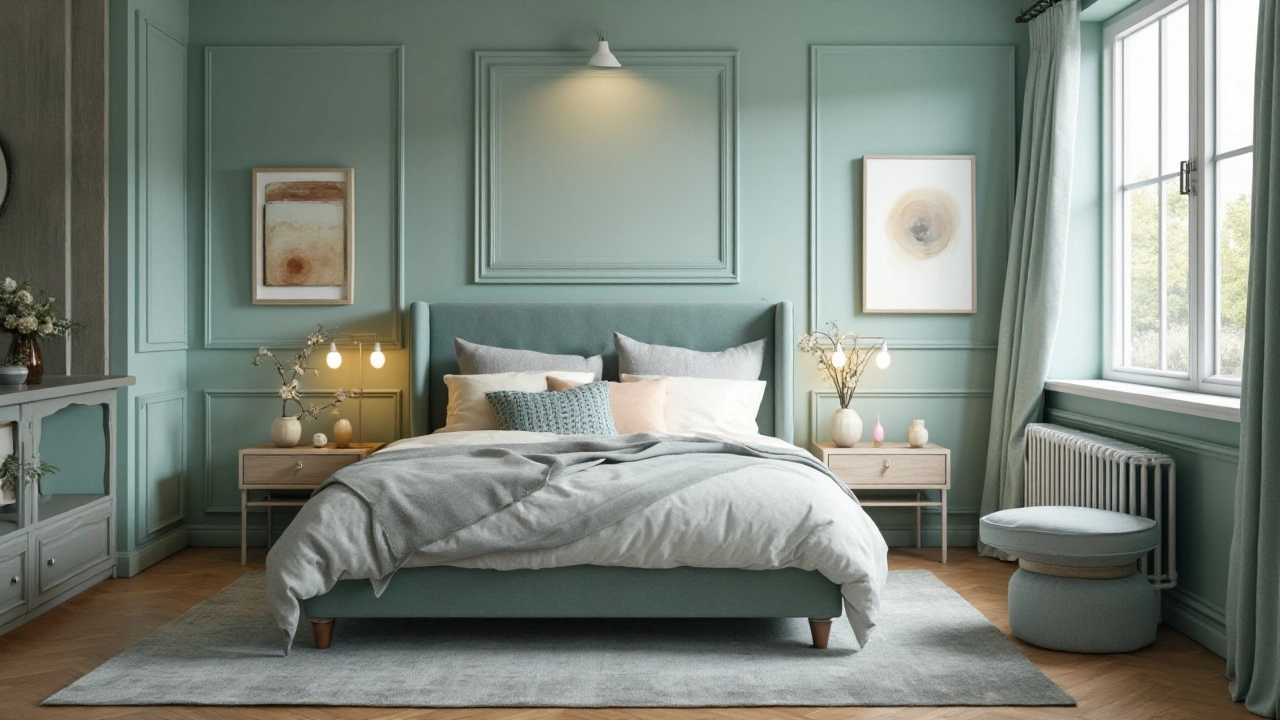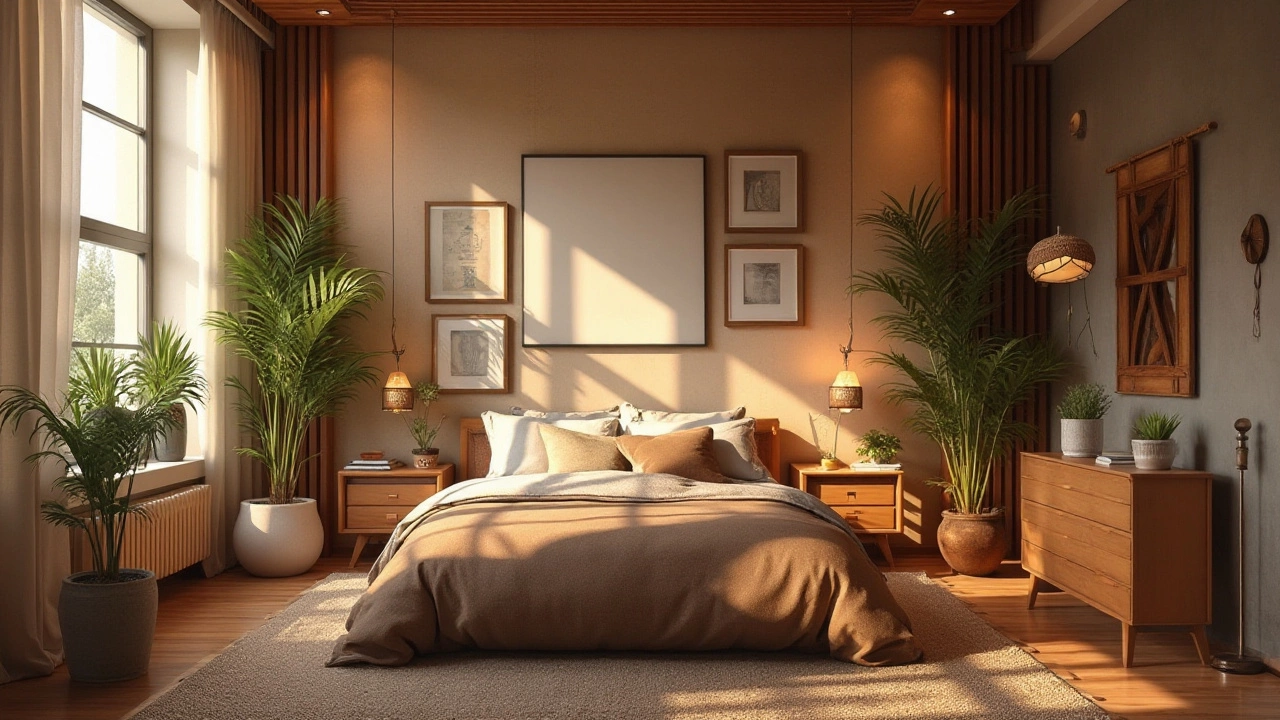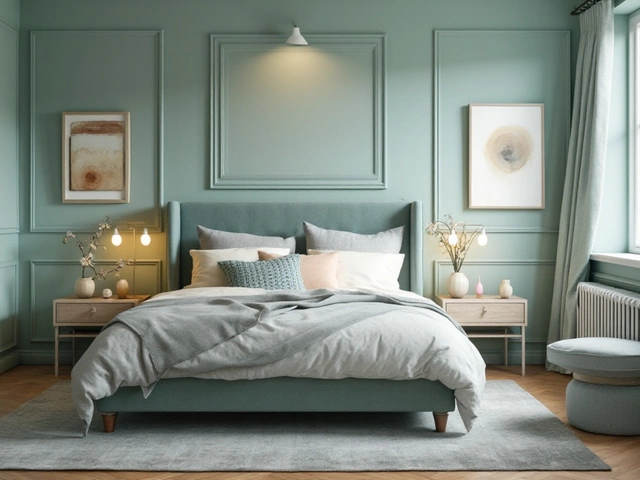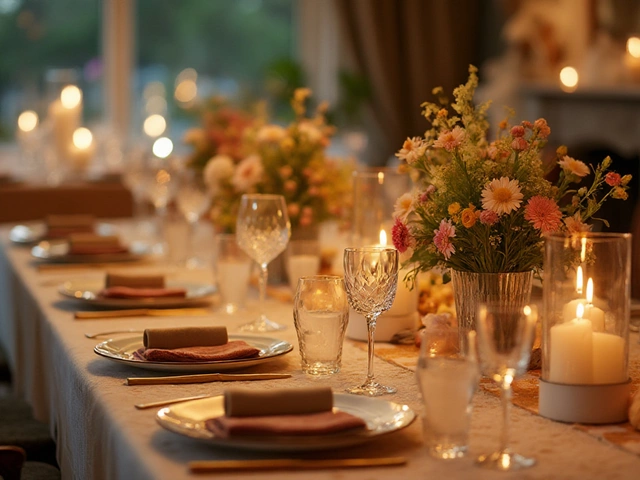
When it comes to making your bedroom look like it was designed by a pro, there are a few core elements to focus on. Most people don't realize that such transformations are within reach. It's all about understanding the basics of design and using them effectively.
Color sets the mood, and choosing the right tones can make or break your space. Think about what vibe you want your bedroom to give – is it a calm sanctuary or a vibrant haven? Once you know, selecting colors becomes easier.
Furniture isn't just about filling space; it's about functionality paired with style. The right pieces will serve their purpose while complimenting the room's aesthetics.
Lighting is another crucial element, not just an afterthought. Different types of lighting can dramatically transform how a room feels.
Your bedroom is a personal space, so let your personality shine through unique decor choices. Remember, it's the small details that often make the most significant impact.
Lastly, don't forget storage and comfort. Clever storage solutions keep clutter at bay, while comfort ensures the room is a place where you love to relax.
- The Role of Color
- Choosing the Right Furniture
- Lighting Magic
- Adding Personal Touches
- Smart Storage Solutions
- Prioritizing Comfort
The Role of Color
Color has the power to create mood and transform spaces, making it one of the most influential aspects of bedroom decor. Think about it: color can evoke emotions, stimulate creativity, and even affect sleep patterns. When planning to decorate your bedroom like an interior designer, understanding how color works is crucial. Imagine walking into a room painted with soothing shades of blue or green; these are known to promote calmness and relaxation. On the other hand, vibrant colors like red or orange can increase energy levels and make a space feel invigorating. It’s not just about the paint on your walls, though. Consider how bedding, curtains, and even artwork contribute to the overall palette of the room.
Many professionals recommend starting with a neutral base. Shades such as white, gray, or beige provide flexibility, allowing you to introduce accents of bold colors through accessories like pillows or throws. For those hesitant about introducing too much color, this approach offers a balanced way to play with creativity without overwhelming the senses. However, choosing colors for your home improvement project involves more than personal preference. The room's size, lighting, and function need consideration. A small room painted in darker hues might feel cramped, whereas the same colors can feel cozy and enveloping when used in a large space.
According to Leatrice Eiseman, a renowned color expert and executive director of the Pantone Color Institute, "The key is to use color as a tool for personal expression and a catalyst for feelings."
Many designers echo the sentiment that your bedroom should reflect your personal style and preferences as much as it meets practical needs.Do not shy away from experimenting, but ensure your choice aligns with the mood you want the space to convey. For example, if sleep is a priority, opt for colors that suggest tranquility and restfulness.
Understanding Color Psychology
The psychology of color is quite fascinating. Blue is often associated with peace and can help reduce stress, potentially improving sleep quality. Yellow, reminiscent of sunlight, is uplifting and energizing, making it a suitable accent in a room where rejuvenation is a goal. Meanwhile, green symbolizes nature and can provide a balanced and harmonious environment, promoting a sense of stability. Consider including these elements subtly through houseplants, which introduce a natural touch while enhancing the room's color scheme. Meanwhile, purple has long been linked with luxury and creativity, and can infuse your personal space with a sense of opulence. Used sparingly, it can also encourage introspection and creativity.
Underestimating the impact of colors is a common oversight among DIY decorators. When in doubt, observe how different lighting conditions affect your chosen palette. Natural light can change color tones dramatically throughout the day, impacting the room's overall vibe. Artificial lighting can, similarly, influence how colors appear, so testing paint samples with different lighting is advisable before making a final decision.
Experimenting with Color Combinations
- Begin with a primary color that resonates with your desired ambiance—be it serene or stimulating.
- Select complementary colors to create balance and harmony.
- Use color wheels and online tools to test different schemes and combinations.
- Don’t be afraid to use bold colors sparingly to add vibrancy and personality to a neutral space.
- Incorporate textures and patterns to add depth and interest without altering the main palette.
Choosing colors for decorating may seem like a daunting task, but it can be an exciting part of the design process, allowing you to express creativity while setting the stage for a truly personalized retreat that you'll enjoy sleeping in and waking up to every day.
Choosing the Right Furniture
When it comes to bedroom decor, one of the most significant aspects is selecting furniture that serves both function and style. It begins with understanding the space you have available and how each piece will contribute to the room's overall harmony. Start by considering your essentials: the bed, nightstands, dresser, and possibly a seating area. The bed is often the focal point; choose a style that fits your taste, whether it’s a classic sleigh bed or a minimalist platform design. Consider the material too – wood offers warmth, while metal might lend a modern edge.
The size of your bedroom will largely determine the dimensions of your furniture. Avoid overcrowding by opting for multi-purpose pieces in smaller spaces, like a bed with built-in storage underneath. When choosing nightstands, balance is key. They don’t have to match the bed precisely, but their scale should complement it. Nightstands offer a great opportunity to incorporate a different material or color that ties into other elements of the room.
Design expert Nate Berkus once said, "Your home should tell the story of who you are, and be a collection of what you love." This philosophy applies especially to your bedroom, a sanctuary that reflects personal taste in every detail.Dressers, too, should be chosen for both practicality and appeal. Think about how much clothing storage you need. Drawers should glide smoothly, and the style should echo other elements in the room, be it through texture or color. In smaller rooms or shared spaces, a tallboy dresser can save floor space while offering ample storage.
Accent furniture like benches or accent chairs can enhance the room's functionality. If space permits, a small loveseat or armchair creates a cozy nook, perfect for unwinding with a book. Ottomans may provide additional storage while also serving as a footrest. Be creative yet strategic with your choices to ensure that each piece you bring into your room adds value to the space. Finally, think about the materials and sustainability. Opt for materials that are durable and have a lower environmental impact. Solid wood furniture might be costlier but proves to be more enduring and timeless.
| Furniture Type | Recommended Material | Functionality |
|---|---|---|
| Bed | Solid wood, metal | Main focal point, style-driven |
| Dresser | Wood with smooth finish | Storage, style balance |
| Nightstand | Wood or mixed material | Functional decor tie-in |
| Accent Chair | Fabric, wood, or metal | Seating, added texture |

Lighting Magic
Lighting is often an underestimated element when decorating a bedroom. Yet, just the right lighting can transform an ordinary space into an extraordinary haven. Natural light is your first ally in creating an uplifting ambiance, so maximize it wherever possible. Position your furniture to embrace the sunlight pouring through the windows. Sheer curtains can filter the light while maintaining privacy, making the room warm and inviting during the day. As the sun sets, artificial lighting takes the lead. Layering your lighting is key, with a combination of ambient, task, and accent lights working together to offer both function and style.
Types of Lighting
There are many types of lighting, but primarily, we focus on three: ambient, task, and accent. Ambient lighting is the base layer, giving the room general illumination. Think about your central ceiling fixture or multiple recessed lights. To enhance this, add dimmer switches that allow you to adjust the brightness according to the mood. Task lighting is more direct, ideal for bedtime reading or a dedicated work area. Bedside lamps with a focused beam are perfect for this purpose. Finally, accent lighting adds drama and highlights specific features or decor in the room. Wall sconces or LED strips behind a headboard can add depth and interest.
Choosing the Right Bulbs
Not all bulbs are created equal, and choosing the right ones can make a significant difference. Pay attention to the bulb's color temperature, usually measured in Kelvins. A lower Kelvin rating creates a warm, cozy glow that is ideal for a relaxing bedroom atmosphere. Typically, aim for bulbs between 2700K to 3000K. Meanwhile, higher Kelvin ratings produce a cool, bluish light that is better suited for energizing areas like a kitchen or a bathroom. Also, consider energy efficiency by opting for LED bulbs, which provide both the desired warmth and longevity, saving you a few extra dollars in the long run.
Smart Lighting Options
In today's tech-savvy world, smart lighting is an option that offers convenience and customization. Imagine adjusting the room's lighting with a voice command or setting it to mimic natural daylight rhythms. Such systems can be programmed to turn on gradually in the morning, helping you wake up gently. At night, they can dim slowly, perfect for winding down. A study found that exposure to warm light in the evening can help regulate sleep patterns, promoting a more restful night's sleep.
"Lighting should be thought about early in the decorating process, not left as an afterthought," advises Kelly Hoppen, a celebrated interior designer.
Creative Lighting Ideas
Don't shy away from creativity. String lights are not just for holiday decorations; they can create a whimsical canopy of stars. A statement chandelier can serve as a centerpiece of your bedroom decor, combining elegance with function. Consider placing light sources at varying heights to create layers of interest. Mixing textures and materials, like glass, fabric, and metals, adds another dimension to your lighting scheme. Exploring these ideas can lend your bedroom a personality as unique as yours.
Adding Personal Touches
When you come home at the end of a long day, your bedroom should be a haven that speaks directly to your soul. To make it truly yours, infuse it with personal touches. These are the elements that make your space not only stylish but also uniquely yours. Start by incorporating items that hold sentimental value. This could be anything from cherished photographs to treasured travel souvenirs. Displaying these in creative ways gives your bedroom character and tells a story of who you are.
Giving walls a personalized flair can start with artwork that resonates with you. Whether it's a piece by your favorite artist or something you hand-painted, art on the walls adds depth and dimension. Don't just stop at paintings; think about other forms of art like wall sculptures or tapestry. Incorporating art into your bedroom decor offers a glimpse into your personality and passions. A quote from the notable Stephen Drucker, former editor of House Beautiful, reminds us,
"Your home should tell the story of who you are and be a collection of what you love brought together under one roof."
The textiles in your room can also be an excellent avenue for personalization. Think about the textures that feel right to you, from the cool, crispness of cotton sheets to the warm embrace of a knitted throw. You might decide to use a bold patterned duvet cover or soft pastel throw pillows. It's these little details that can make a significant difference, altering the ambiance of your bedroom. Additionally, greenery can add life and serenity to your space. Whether you have a green thumb or prefer low-maintenance succulents, plants introduce a natural element that can be calming and refreshing.
Adding personal touches in the form of DIY projects can be a rewarding endeavor. Consider creating your headboard, even if it's as simple as using vintage doors or reclaimed wood. This allows your creativity to shine and ensures your room is one-of-a-kind. These projects can be great weekend activities that potentially involve friends or family, adding an additional layer of personalization through shared experiences. Finally, let’s not forget about the power of aromas. Personalize your room with scents that you love, whether from candles, essential oils, or incense. Fragrance has the innate ability to transform the feel of a room, making it as personal and inviting as possible.

Smart Storage Solutions
Organizing your bedroom with smart storage solutions can significantly enhance both the functionality and aesthetic appeal of your space. Let's face it, clutter can easily transform a serene atmosphere into a chaotic one. The first step is to assess what you actually need versus what is occupying unnecessary space. Tidiness begins with wise decision-making about what stays and what goes away. Consider under-bed storage as a way to capitalize on often unused space. Under-bed storage boxes, which can be easily rolled out, are perfect for seasonal clothing or extra bedding, offering a quick access to items you might not need every day but certainly want to have at hand.
Your closet can also become a power player in maintaining order in your bedroom decor. Invest in a customizable closet system with adjustable shelves and hanging rods. This not only maximizes your existing space but allows for the organization to evolve as your needs change. A little-known fact is that vertical space is often underutilized. Use wall-mounted shelves or over-door racks to keep your belongings visible and accessible without taking up floor space. Remember, the goal is to find what you need when you need it without a scavenger hunt.
Another great trick is incorporating multi-functional furniture. Pieces like ottomans with hidden storage, or a bed with built-in drawers, can provide a wealth of storage opportunities without sacrificing style. These types of dual-function furnishings are especially beneficial in smaller bedrooms, where every inch counts. Don't forget about the smart use of decor—think baskets or decorative boxes on shelves, which add a touch of design flair while maintaining practicality. Using storage as decoration is both clever and efficient.
Creative Ways to Use Storage
Mounting hooks or pegs on the wall not only saves floor space but adds a quaint charm when used to hang hats, bags, or even jewelry. For book lovers, consider a headboard with integrated bookshelves. It becomes an extension of the bed, efficiently using space that would otherwise remain unutilized. In fact, according to a study, using space-saving furniture can increase the useable area of small bedrooms by up to 50%. Think of your bedroom as a canvas and storage solutions as the paint—it’s all about layering and using what’s available to create something unique and personal.Psychologist Sherrie Bourg Carter notes, "Clutter can play a significant role in how we feel about our homes, our workplaces, and ourselves. Messy homes and workspaces leave us feeling anxious, helpless, and overwhelmed."
Decluttering and organizing your space can lead to a happier, more productive life.So, when contemplating your next move in improving bedroom storage, prioritize both functionality and aesthetics. Taking time to carefully consider each piece and its place will not only improve the room's appearance but also its efficiency.
Prioritizing Comfort
When it comes to bedroom decor, many folks overlook the true essence of comfort. This is the space where you begin and end your day; it's your haven, not just part of the house. Comfort in the bedroom goes beyond just the mattress and bedding. It encompasses every element, from the feel of the carpet under your feet to the ambient temperature as you rest. To create a cozy atmosphere, first tackle the bed, which is rightly the centerpiece. Choose a mattress that suits your sleeping style, whether that’s firm for support or plush for softness. Don’t skimp on quality because investing in a good mattress can improve both your sleep and your health significantly. A study by the Sleep Foundation highlights that a comfortable bed can enhance sleep quality by up to 50% regardless of age, thanks to reducing pressure points and providing proper alignment.
Next, think about the bedding. Opt for high-thread-count sheets made from breathable materials like cotton or bamboo, which help regulate body temperature through the night. This prevents overheating, allowing you to enjoy uninterrupted sleep. Pillows are equally pivotal; they should hold your head at the correct angle, supporting your neck. Regularly evaluate your pillow’s condition – if it’s more than two years old or causing kinks in your neck, it might be time for a replacement.
For creating a tranquil environment, sound and smell play important roles too. Consider a white noise machine to drown out disruptive sounds from outside or a diffuser with calming scents like lavender or chamomile, which are known for helping to relax the mind and body. Harvard Medical Publications emphasize the affective power of scent on our overall mood and stress levels, suggesting that a pleasing aroma can make your space more inviting and restful.
The temperature setting can also impact your comfort levels. Both overly chilly and warm environments can disrupt your sleep pattern. As a rule of thumb, a bedroom temperature of around 65°F (18°C) is often recommended as perfect for sleep. If that feels a bit nippy, cozy throws or an electric blanket might just become your best friends. Just remember, the goal is a space that feels tailor-made for unwinding.
"Comfort in your bedroom decor isn't just about stepping into a well-designed space; it's about stepping into a space that feels uniquely yours," says renowned interior designer Kelly Hoppen. Her approach underlines an essential truth — that comfort is highly personal, and only you can decide what comfort truly means in your space.
Finally, don’t neglect the impact of natural light during the day and artificial lights during the night on your comfort. Invest in blackout curtains if you're sensitive to morning light but also ensure your room isn't too dark during the day. For the night, choose bedside lamps with adjustable lighting options to help transition from alertness to relaxation. This cohesive approach combines aesthetics with practicality, ensuring your bedroom decor doesn't just look good but feels just right for you.



